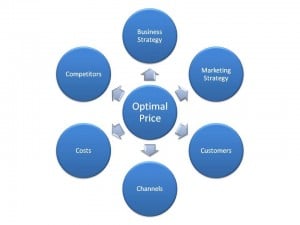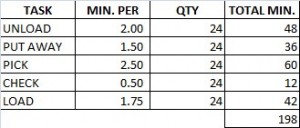In our earlier blog post (part 1 of 2) on logistics pricing, the topic was space. The purpose of this blog post is to now discuss the other major component of logistics pricing in our industry: labor.
Understanding Labor Logistics Pricing
The first disclaimer I must make is I believe “pricing” is a management decision, and “costing” is a calculated estimate based on assumptions and data. So, when we talk about “pricing”, everything that has gotten us up to the point of offering a price to a customer may be based on costing, but may also be influenced by other factors:
- Market conditions
- Goals of the company
- Interest in obtaining a new customer
In this blog post, we will explore both costing and pricing.
Also in the January blog post, it was mentioned the world of pricing runs the gamut. From Mom & Pop companies, who quote new business off a rate sheet that has hung on the office wall since Grandpa was in charge; to multinational 3PLs with complex pricing models tied to real-time cost data and engineered labor standards. While the range of pricing (and costing) tools can run the gamut, at the end of the day, the company that understands the cost to serve the customer (and the shareholders) uses that information in their pricing decisions have the formula for success. Myriad of questions:
- How much does it cost to serve a potential customer?
- How do I find out?
- What do I need to know, and who can I ask?
- What if the information is wrong, or changes?
Let’s Break It Down and Look At The Pieces…
What is the basic process performed on product handled by a 3PL? Receive, inspect, put away, pick, check, load. There are others, but these are the basics. Which processes will you include in your pricing? Which ones add value in the eyes of the customer?
Let’s keep it simple and look at an opportunity with full truckloads in and out, with full pallet handling (no loose cases, no pick and pack) and only 1 SKU.
We first need to understand the processes that are required in order to meet the customer’s requirements, and understand the costs related to accomplish those processes.
Now we know it will require 198 minutes per truckload for handling. We should simply be able to multiply that time by the volume of trucks we anticipate, and arrive at the annual time needed to serve this customer.
If this customer anticipates 1 truck per weekday, then we can multiply 198 minutes by 5 days per week, by 52 weeks = 51,480 minutes. Divided by 60 gives us 858 hours per year to serve this customer. If our average forklift driver earns $15 per hour, and has a benefit and tax burden of 40%, then we need to charge $21 per hour for his/her service ($15*1.40%=$21.00)
Multiply $21.00 per hour by 858 hours to get an annual labor cost of $18,018.
- The customer wants an all-in handling price for all activities combined
$18,018 / 24 pallets per truck / 5 trucks per week / 52 weeks = $2.89 per pallet
We used observations or time studies to calculate the time to complete each task in the handling process, used our known loaded cost per hour for a forklift driver. Are we done? NO. We have only covered the cost of the forklift driver for the actual work that he/she does (direct time).
Accounting For The Rest Of It
We need to account for the cost of paid time that is not worked (vacation and holidays). We need to account for indirect time at the start and end of each shift (when the driver is not actively unloading or loading) and may be performing a pre-shift inspection of the forklift, battery change, attending a start-up meeting, taking a safety class, new-hire orientation, open enrollment for benefits, taking a rest break or an extended lunch break, etc.
Additionally, it is not reasonable to assume that every person is capable of working at the same speed throughout the day, or at the same speed of every other person. What pace is the right pace? Which indirect activities add value in the eyes of the customer? How long should a battery change take?
We need to account for the general manager, operations manager, supervisor, lead person and clerical support that may not handle the pallets, but contribute to our ability to meet the customer’s requirements.
We need to consider the travel time required to put pallets away, pick and stage pallets on the dock. There may be time required to spot trailers at the dock doors with a yard driver. The cost of that driver (and his/her tractor, fuel, insurance, maintenance) may need to be considered. The cost of the forklift, and related fuel and maintenance, and utilization, and repairs…and so on.
What about the ramp-up time allowed for new associates to get up to speed while training? How do we account for that? Do we need to also consider the cost of employee turnover into our handling costs? What other costs can be allocated to the cost of handling?
It is wise to take a look at all of the costs on your general ledger to see which costs can be allocated to space, and which can be allocated to labor. Those that cannot be allocated to either should become “overhead” and allocated to your bid as a known percentage.
Determining The Price
Let’s now assume you understand the cost to serve your potential new customer. You also know you wish to make a profit of 10%. This should be the final step in determining price, right?
If your fully loaded cost per pallet is $5.00, and you wish to make 10%, you would offer a rate of $5.50 per pallet. What price will the market bear? What are your competitors charging? Are their costs similar to yours? Might they be more aggressive in their pricing in order to ensure that you do not win the new customer? Do they have “extra” space available they are willing to take a loss (or simply break even) in order to profit from only the handling?
You cannot certainly know all of the answers to these questions. I would suggest you only try to answer those questions about your competitors if it helps you understand your business more completely. There are enough moving parts within your organization to influence cost already.
Cost is not the only consideration involved in the pricing decision. Pricing is a management decision made based on available information, an understanding of the strategic goals of the business, and how this new potential customer helps to meet those goals.
Offering your services at a margin less than your target may meet your strategic objectives if growth is a priority. Walking away from this opportunity may meet your strategic objectives if your margin targets cannot be met.
To Sum It All Up
Some companies believe the price of a service is comprised of the cost to serve the customer plus the profit that is desired.
(cost + profit = price)
The flaw in this formula is revealed when a business does not manage their costs, and assumes that a customer is willing to pay for inefficiency, waste, non-value-added activities. As an alternative, companies may wish to consider price as being driven by the market, and cost being driven by the effectiveness of the service provider (company).
(price – cost = profit)
This change in mindset will help restructure the way your company thinks about profit. Profit is now achieved by reducing costs, eliminating waste and not performing non-value-added activities in the eyes of the customer.
If you are interested in learning more best practices and tips on warehousing, check out our eBook: The ABCs of DCs.



